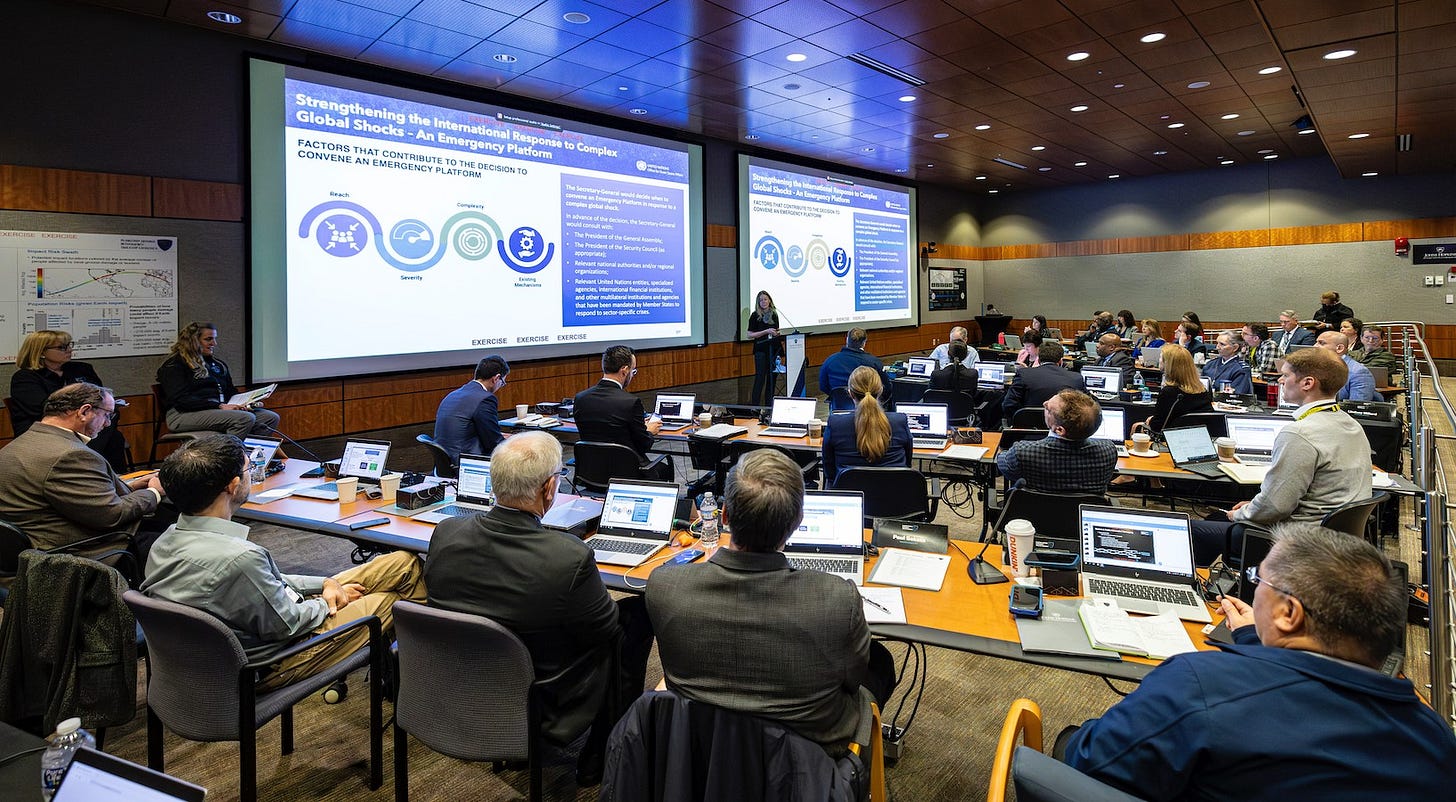Global Shield Briefing (2 October 2024)
Complex global shocks, tabletop exercises, and societal resilience
The latest policy, research and news on global catastrophic risk (GCR).
Homo sapiens became a formidable species not only due its ability to learn and adapt. It was due to its ability to transfer that knowledge from generation to generation. Individual intelligence became collective memory. Through oral stories, and later, the written word, our ancestors embedded the wisdom of their experiences into their cultural fabric. In parts of Japan, centuries-old stones dot the coastline, serving as a silent warning for the region’s locals. In the village of Aneyoshi, an unambiguous message is etched into the rock slab: “Remember the calamity of the great tsunamis. Do not build any homes below this point.” These days, our institutions seem almost incapable of learning the lessons from recent crises. Constant shocks and global access to a torrent of information have, ironically, it seems, paralyzed us. But nil desperandum; there are those placing the stones now for the next generation. As long as they listen.
Responding to complex global shocks

The United Nations held the Summit of the Future over 22-23 September in New York. At the Summit, Member States adopted the Pact for the Future, as well as two annex documents, the Global Digital Impact and the Declaration on Future Generations. The Pact for the Future aims to reinvigorate the multilateral system, and outlines 56 actions across sustainable development, international peace and security, science and technology, youth and future generations, and global governance.
The Pact recognizes that: “We [humanity] are confronted by rising catastrophic and existential risks, many caused by the choices we make. Fellow human beings are enduring terrible suffering. If we do not change course, we risk tipping into a future of persistent crisis and breakdown.”
Further, the Pact contains an action around complex global shocks. Action 54 states that “We recognize the need for a more coherent, cooperative, coordinated and multidimensional international response to complex global shocks and the central role of the United Nations in this regard” and requests the Secretary-General to “Consider approaches to strengthen the United Nations system response to complex global shocks”.
Policy comment: Unfortunately, despite the efforts of many in civil society, including Global Shield and David Miliband of the International Rescue Committee, the action on complex global shocks provides a less ambitious and definitive direction for improving the response to complex global shocks than it did in the Pact’s “zero draft”. This earliest version called for the development of an “Emergency Platform” – a Secretary-General proposal to establish a mechanism that coordinates across the UN system in response to a global crisis. COVID-19 and the war in Ukraine revealed that the UN lacks an effective response mechanism when a crisis presents a complex challenge across different domains and UN bodies. The more modest direction to the Secretary-General – without explicit endorsement or rejection of the Emergency Platform concept – indicates the challenges of finding consensus to improve the multilateral system’s management of global risk. However, the more open-ended wording provides an opportunity for the Secretary-General to consider a range of possible approaches. For example, in addition to emergency platforms, the UN system could also look to further enable existing bodies of the UN, such as improving and expanding the humanitarian cluster system approach of the Office for the Coordination of Humanitarian Affairs (OCHA) to include other challenges arising from a global catastrophe. The Secretary-General might also wish to improve mechanisms that better coordinate preparedness and resilience for global shocks.
Also see:
A new report by the Stimson Center laying out a detailed explanation of the evolution of the Emergency Platform proposal prior to the Summit, as well as potential next steps.
Getting exercise on global catastrophic risk

In April, nearly 100 members of the planetary defense community participated in the 5th Planetary Defense Interagency Tabletop Exercise. Sponsored by NASA, the US Federal Emergency Management Agency and the US Department of State Office of Space Affairs, the purpose of the exercise was to help inform preparedness and planning for an asteroid impact. Participants from about 20 federal agencies and eight international partners considered the scenario of a 72% chance that an asteroid hits Earth in 14 years, with an impact potentially destroying an area of country-to-regional level. FEMA’s detailee to the NASA’s Planetary Defence Coordination Office noted that, while the UN had procedures for responding to tsunamis and other big events, the scale of an asteroid impact required a greater and earlier international response.
Asteroid detection and planning remains one of the best examples of policy success for reducing existential risk.
Policy comment: These tabletop exercises are needed for all scenarios of global catastrophe. Imagine if a systemic, senior-level exercise program was held for a range of catastrophes, like nuclear winter, climate tipping points or an engineered pandemic to regularly test the limits of government capabilities. Asteroid-based scenarios are exercised every few years even though a globally catastrophic asteroid impact is unlikely, and considerably less probable than human-driven catastrophic threats. The US government has a well-developed strategy and action plan for near-Earth objects, yet this fifth tabletop exercise identified a number of issues and recommendations. This shows that regular and serious tabletop exercises help improve government planning and preparedness. For example, the after-action report highlighted gaps in international coordination mechanisms, roles and responsibilities, decision-making processes, disaster management plans, capability needs and public messaging. Governments could transfer the lessons from this effort to exercise other catastrophes, including scenario development, whole-of-government coordination, engagement with international partners and researchers, and incorporation of learnings into government policy.
Also see:
A recent article in Nature Communications explaining the role of the International Asteroid Warning Network (IAWN) and the Space Mission Planning Advisory Group (SMPAG).
A recent editorial by the Washington Post Editorial Board providing an overview of preparedness for an asteroid impact.
A piece in The Conversation on recent improvements in asteroid detection.
Building societal resilience to AI risk

A report by CNAS outlines the various ways in which artificial intelligence contributes to catastrophic risk. In addition to enabling new capabilities and exacerbating system failures, AI increases risk by reducing social resilience through AI-fueled disinformation. According to the report, “Societies’ relative resilience to degraded media ecosystems could have considerable effects on states’ ability to respond to crises—influencing the degree to which smaller-scale crises can be effectively curbed from becoming full-blown catastrophes, or how great the overall impacts of a catastrophe become.”
In an alarming real-world anecdote, the US Senate Foreign Relations Committee Chair Ben Cardin (D-Md.) was reportedly the target of a sophisticated deepfake operation. According to the report, Sen. Cardin was on a Zoom call with an individual impersonating Ukraine’s recently-former foreign minister Dmytro Kuleba, seeking to trick Sen. Cardin into commenting on politically charged topics.
A June report by Founders Pledge assesses that “governments are not prepared for the dangers that advanced AI will very soon pose” and provides a number of recommendations for philanthropists, including to fund efforts that would “increase global resilience to cover cases where existing AI risk defenses fail to restrain localized catastrophic events.”
Policy comment: Governments must improve societal resilience – like social cohesion and trust in institutions – to global catastrophic risk, which would help capture the risk posed by AI. If AI were to directly contribute to a catastrophic event, the laws and policies that would be needed to reduce the consequences are applicable to a range of hazards. As the Founders Pledge report states, “interventions which increase global resilience do not just reduce the chance of AI takeover – they also provide defenses against other threat models.” These interventions could include scenario planning and ‘wargaming’, protection of critical infrastructure, emergency management and response, and law enforcement and national security capabilities. Societal resilience is particularly important given the disruptive nature of global catastrophic risk, and AI in particular. A global catastrophe would severely test social cohesion, government response capacity, and ability to recover and rebuild. Ensuring citizens can effectively access and interpret information, while keeping the media ecology as healthy as possible, would position society for periods of serious crisis and turbulence.
Also see:
A June piece in the Bulletin of the Atomic Scientists that looks at the rise of AI-enabled surveillance technologies.
The New Scientist’s tips on assessing AI-generated images, videos and audio.
This briefing is a product of Global Shield, the world’s first and only advocacy organization dedicated to reducing global catastrophic risk of all hazards. With each briefing, we aim to build the most knowledgeable audience in the world when it comes to reducing global catastrophic risk. We want to show that action is not only needed, it’s possible. Help us build this community of motivated individuals, researchers, advocates and policymakers by sharing this briefing with your networks.

